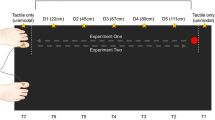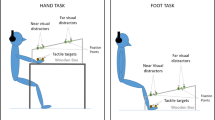Abstract
To guide the movement of the body through space, the brain must constantly monitor the position and movement of the body in relation to nearby objects. The effective piloting of the body to avoid or manipulate objects in pursuit of behavioural goals requires an integrated neural representation of the body (the ‘body schema’) and of the space around the body (‘peripersonal space’). In the review that follows, we describe and evaluate recent results from neurophysiology, neuropsychology, and psychophysics in both human and non-human primates that support the existence of an integrated representation of visual, somatosensory, and auditory peripersonal space. Such a representation involves primarily visual, somatosensory, and proprioceptive modalities, operates in body-part-centred reference frames, and demonstrates significant plasticity. Recent research shows that the use of tools, the viewing of one’s body or body parts in mirrors, and in video monitors, may also modulate the visuotactile representation of peripersonal space.




Similar content being viewed by others
Notes
Head and Holmes (1911–1912, pp. 186–189) distinguished two principal aspects of the ‘body schema’ based on a neurological understanding of the dissociations in bodily sensibility that follow selective lesions of the spinal cord, brainstem, thalamus, and cerebral cortex. The ‘postural schema’ represents the position and movement of the body, and is derived primarily from proprioceptive and kinaesthetic afferent impulses. Their second schema is derived from cutaneous afferent impulses signalling the location of tactile stimuli on the surface of the body. These schemata are independent from, though related to, conscious ‘images’ of the body. Many separate classifications of ‘body schema’ and ‘body image’ have followed this original definition. For clarity, however, we adhere to the neurological taxonomy of Head and Holmes, while acknowledging that the body schema should not necessarily be restricted to proprioceptive and somatosensory modalities alone, but should also incorporate visual and perhaps even auditory information as well (for a range of perspectives on the body schema see, for example, Berlucchi and Aglioti 1997; Schilder 1935; the chapters in Bermúdez et al. 2003; and the proceedings of a recent conference at http://allserv.rug.ac.be/~gvdvyver/body-image/hoofdblad.htm).
The term ‘reference frame’ is used to refer to the centre of a coordinate system for representing objects, including the body itself, and relations between objects (e.g., Cohen and Andersen 2002). For example, a retinotopic reference frame would take as its centre the fovea of each retina and would represent visual objects in relation to this origin. In a head-centred reference frame, objects are represented independently of eye movements, and in a body-centred frame, independently of both head and eye movements. Both body-centred and body-part-centred frames may be important in the representation of peripersonal space.
The requirement for the hands to be visible for ‘visual’ peripersonal space to be stimulated more effectively raises an interesting question. Does the reduction in visuotactile extinction when the right hand is not visible depend on there being a physical barrier between the visual stimulus and the hand, or simply on the occlusion of vision of the hand itself? Farnè et al. (2003) have recently addressed this question in a patient suffering from crossmodal extinction. They showed that the insertion of a transparent barrier between the visual stimulus applied near the right hand and the hand itself had no effect on the proportion of left tactile stimuli extinguished in comparison to peripersonal right visual stimulation in the absence of any barrier. By contrast, an opaque barrier that occluded vision of the hand resulted in a significant decrease in the number of left tactile stimuli extinguished by simultaneous right visual stimuli just above the barrier. This result suggests that it is not simply the presence of a barrier itself, but rather the occlusion of vision of the body part that is important in modulating visuotactile crossmodal extinction.
References
Austen EL, Soto-Faraco S, Pinel JPJ, Kingstone AF (2001) Virtual body effect: factors influencing visual-tactile integration. Abstracts Psychon Soc 6:2
Berlucchi G, Aglioti SA (1997) The body in the brain: neural bases of corporeal awareness. Trends Neurosci 20:560–564
Berti A, Frassinetti F (2000) When far becomes near: re-mapping of space by tool-use. J Cogn Neurosci 12:415–420
Bonnier P (1905) L’Aschématie [Aschematia]. Rev Neurol 13:606–609
Botvinick M, Cohen J (1998) Rubber hands ‘feel’ touch that eyes see. Nature 391:756
Bermúdez JL, Marcel AJ, Eilan N (eds) (2003) The body and the self. MIT Press, Cambridge, Mass.
Chapman CE, Spidalieri G, Lamarre Y (1984) Discharge properties of area 5 neurones during arm movements triggered by sensory stimuli in the monkey. Brain Res 309:63–77
Cohen YE, Andersen RA (2002) A common reference frame for movement plans in the posterior parietal cortex. Nat Rev Neurosci 3:553–562
Colby CL, Duhamel J (1991) Heterogeneity of extrastriate visual areas and multiple parietal areas in the macaque monkey. Neuropsychologia 29:517–537
Craig JC, Rollman GB (1999) Somesthesis. Annu Rev Psychol 50:305–331
di Pellegrino G, Frassinetti F (2000) Direct evidence from parietal extinction of enhancement of visual attention near a visible hand. Curr Biol 10:1475–1477
di Pellegrino G, Làdavas E, Farnè A (1997) Seeing where your hands are. Nature 388:730
Farnè A, Demattè ML, Làdavas E (2003) Beyond the window: multisensory representation of peripersonal space across a transparent barrier. Int J Psychophysiol 50:51–61
Farnè A, Làdavas E (2000) Dynamic size-change of hand peripersonal space following tool use. Neuroreport 11:1645–1649
Farnè A, Làdavas E (2002) Auditory peripersonal space in humans. J Cogn Neurosci 14:1030–1043
Farnè A, Pavani F, Meneghello F, Làdavas E (2000) Left tactile extinction following visual stimulation of a rubber hand. Brain 123:2350–2360
Fogassi L, Gallese V, Fadiga L, Luppino G, Matelli M, Rizzolatti G (1996) Coding of peripersonal space in inferior premotor cortex (area F4). J Neurophysiol 76:141–157
Graziano MSA (1999) Where is my arm? The relative role of vision and proprioception in the neuronal representation of limb position. Proc Natl Acad Sci U S A 96:10418–10421
Graziano MSA, Gross CG (1993) A bimodal map of space: somatosensory receptive fields in the macaque putamen with corresponding visual receptive fields. Exp Brain Res 97:96–109
Graziano MSA, Gross CG (1995) The representation of extrapersonal space: a possible role for bimodal, visual-tactile neurons. In: Gazzaniga MS (ed) The cognitive neurosciences. MIT Press, Cambridge, pp 1021–1034
Graziano MSA, Yap GS, Gross CG (1994) Coding of visual space by premotor neurons. Science 266:1054–1057
Graziano MSA, Hu XT, Gross CG (1997a) Coding the locations of objects in the dark. Science 277:239–241
Graziano MSA, Hu XT, Gross CG (1997b) Visuospatial properties of ventral premotor cortex. J Neurophysiol 77:2268–2292
Graziano MSA, Reiss LA, Gross CG (1999) A neuronal representation of the location of nearby sounds. Nature 397:428–430
Graziano MSA, Cooke DF, Taylor CSR (2000) Coding the location of the arm by sight. Science 290:1782–1786
Graziano MSA, Taylor CSR, Moore T (2002) Complex movements evoked by microstimulation of precentral cortex. Neuron 34:841–851
Haggard P, Taylor-Clarke M, Kennett S (2003) Tactile perception, cortical representation and the bodily self. Curr Biol 13:170–173
Halligan PW, Marshall JC (1991) Left neglect for near but not far space in man. Nature 350:498–500
Halligan PW, Hunt M, Marshall JC, Wade DT (1996) When seeing is feeling: acquired synaesthesia or phantom touch? Neurocase 2:21–29
Head H, Holmes HG (1911–1912) Sensory disturbances from cerebral lesions. Brain 34:102–254
Held R, Durlach N (1993) Telepresence, time delay and adaptation. In: Ellis SR, Kaiser MK, Grunwald AC (eds) Pictorial communication in virtual and real environments. Taylor & Francis, London, pp 232–246
Hoover RE (1950) The cane as a travel aid. In: Zahl PA (ed) Blindness. Princeton University Press, Princeton, pp 353–365
Iriki A, Tanaka M, Iwamura Y (1996a) Coding of modified body schema during tool use by macaque postcentral neurones. Neuroreport 7:2325–2330
Iriki A, Tanaka M, Iwamura Y (1996b) Attention-induced neuronal activity in the monkey somatosensory cortex revealed by pupillometrics. Neurosci Res 25:173–181
Iriki A, Tanaka M, Obayashi S, Iwamura Y (2001) Self-images in the video monitor coded by monkey intraparietal neurons. Neurosci Res 40:163–175
Kalaska JF, Cohen DAD, Prud’homme M, Hyde ML (1990) Parietal area 5 neuronal activity encodes movement kinetics, not movement dynamics. Exp Brain Res 80:351–364
King AJ (1999) Sensory experience and the formation of a computational map of auditory space in the brain. Bioessays 21:900–911
Làdavas E (2002) Functional and dynamic properties of visual peripersonal space. Trends Cogn Sci 6:17–22
Làdavas E, di Pellegrino G, Farnè A, Zeloni G (1998) Neuropsychological evidence of an integrated visuotactile representation of peripersonal space in humans. J Cogn Neurosci 10:581–589
Làdavas E, Farnè A, Zeloni G, di Pellegrino G (2000) Seeing or not seeing where your hands are. Exp Brain Res 131:458–467
Làdavas E, Pavani F, Farnè A (2001) Auditory peripersonal space in humans: a case of auditory-tactile extinction. Neurocase 7:97–103
Làdavas E, Zeloni G, Farnè A (1998) Visual peripersonal space centred on the face in humans. Brain 121:2317–2326
MacKay WA, Crammond DJ (1987) Neuronal correlates in posterior parietal lobe of the expectation of events. Behav Brain Res 24:167–179
Maravita A, Husain M, Clarke K, Driver J (2001) Reaching with a tool extends visual-tactile interactions into far space: evidence from cross-modal extinction. Neuropsychologia 39:580–585
Maravita A, Spence C, Clarke K, Husain M, Driver J (2000) Vision and touch through the looking glass in a case of crossmodal extinction. Neuroreport 11:3521–3526
Maravita A, Spence C, Kennett S, Driver J (2002a) Tool-use changes multimodal spatial interactions between vision and touch in normal humans. Cognition 83:25–34
Maravita A, Spence C, Sergent C, Driver J (2002b) Seeing your own touched hands in a mirror modulates cross-modal interactions. Psychol Sci 13:350–355
Mattingley JB, Driver J, Beschin N, Robertson IH (1997) Attentional competition between modalities: extinction between touch and vision after right hemisphere damage. Neuropsychologia 35:867–880
Moll L, Kuypers HGJM (1977) Premotor cortex ablations in monkeys: contralateral changes in visually guided reaching behavior. Science 198:317–319
Mountcastle VB, Lynch JC, Georgopoulos AP, Sakata H, Acuna C (1975) Posterior parietal association cortex of the monkey: command functions for operation within extrapersonal space. J Neurophysiol 38:871–908
Nielsen TI (1963) Volition: a new experimental approach. Scand J Psychol 4:225–230
Obayashi S, Tanaka M, Iriki A (2000) Subjective image of invisible hand coded by monkey intraparietal neurons. Neuroreport 11:3499–3505
Pavani F, Spence C, Driver J (2000) Visual capture of touch: out-of-the-body experiences with rubber gloves. Psychol Sci 11:353–359
Popper KR, Eccles JC (1977) The self and its brain. Springer, London Berlin Heidelberg
Previc FH (1998) The neuropsychology of 3-D space. Psychol Bull 124:123–164
Ramachandran VS, Rogers-Ramachandran D (1996) Synaesthesia in phantom limbs induced with mirrors. Proc R Soc Lond B Biol Sci 263:377–386
Ramachandran VS, Rogers-Ramachandran D, Cobb S (1995) Touching the phantom limb. Nature 377:489–490
Rizzolatti G, Fadiga L, Gallese V, Fogassi L (1996) Premotor cortex and the recognition of motor actions. Cogn Brain Res 3:131–141
Rizzolatti G, Fadiga L, Fogassi L, Gallese V (1997) The space around us. Science 277:190–191
Rizzolatti G, Luppino G, Matelli M (1998) The organization of the cortical motor system: new concepts. Electroencephalogr Clin Neurophysiol 106:283–296
Rorden C, Heutink J, Greenfield E, Robertson IH (1999) When a rubber hand ’feels’ what the real hand cannot. Neuroreport 10:135–138
Sathian K, Greenspan AI, Wolf SL (2000) Doing it with mirrors: a case study of a novel approach to neurorehabilitation. Neurorehabil Neural Repair 14:73–76
Schilder PF (1935) The image and appearance of the human body: studies in the constructive energies of the psyche. Kegan Paul, Oxford
Spence C, Pavani F, Maravita A, Holmes NP (2004) Multisensory contributions to the 3-D representation of visuotactile peripersonal space in humans: evidence from the crossmodal congruency task. J Physiol (in press)
Acknowledgements
N.P. Holmes is supported by a Wellcome Prize Studentship (number 065696/Z/01/A) from The Wellcome Trust.
Author information
Authors and Affiliations
Corresponding author
Additional information
Edited by: Marie-Hélène Giard and Mark Wallace
Rights and permissions
About this article
Cite this article
Holmes, N.P., Spence, C. The body schema and multisensory representation(s) of peripersonal space. Cogn Process 5, 94–105 (2004). https://doi.org/10.1007/s10339-004-0013-3
Received:
Revised:
Accepted:
Published:
Issue Date:
DOI: https://doi.org/10.1007/s10339-004-0013-3




